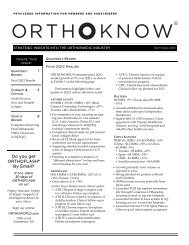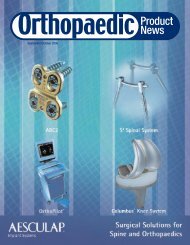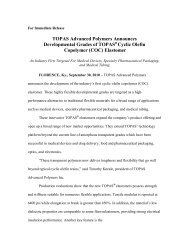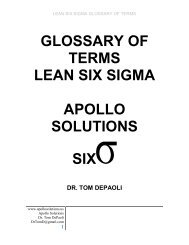Hip & Knee Surgery - Orthoworld
Hip & Knee Surgery - Orthoworld
Hip & Knee Surgery - Orthoworld
Create successful ePaper yourself
Turn your PDF publications into a flip-book with our unique Google optimized e-Paper software.
FUTURETECHThromboembolic DiseasePrevention in Spine <strong>Surgery</strong>: TheRole of a Novel PneumaticCompression DeviceAuthor: Isador Lieberman, M.D., M.B.A., F.R.C.S.C.Venous thromboembolic (VTE) disease is a common complicationof total joint arthroplasty that has been recognized since theNational Institutes of Health consensus conference in 1986. Withoutprophylaxis, the rate of deep venous thrombosis (DVT) after totaljoint arthroplasty ranges between 40 percent and 85 percent,depending on the surgical procedure involved. Since 90 percent ofsymptomatic pulmonary emboli (PE) are estimated to originatefrom lower extremity DVT, prevention of DVT has become thestandard of care after total joint interventions. 1Despite the medical consensus that exists around this issue, thegap between current practice and optimal practice is large, and PEis still the most common preventable cause of death in the hospital.An estimated 10 percent of in-hospital deaths are secondary to PE—more annual deaths than those from breast cancer, AIDS and trafficaccidents combined. 2The high prevalence of hospital-acquired VTE is largely due tothe underutilization of the currently recommended prophylacticprotocols. Excellent methods of chemoprophylaxis using warfarin,low-molecular-weight heparin (LMWH) or fondaparinux areavailable. Chemoprophylaxis, however, carries a bleeding risk ashigh as five percent. Mechanical methods of prophylaxis, mainlyintermittent pneumatic compression (IPC) devices, continue to be anattractive option because very few complications have been identifiedwith their use. However, the benefits of mechanical devices arelimited by poor compliance, and the potential benefits have not beenproven in clinical trials vs. commonly used anti-coagulants.Consequently current recommended prophylaxis protocols arebased on anticoagulants, and the use of mechanical prophylaxis isrelegated to those patients with higher bleeding risk or as an adjunctto anticoagulant-based prophylaxis. 1 The decision-making processthat led to the above recommendations was based upon “fearbalance” between postoperative VTE risk and bleeding risk.While the risks for VTE and bleeding in lower extremityorthopaedic surgery have been studied intensively and are welldefined, the risks during spinal surgery are not yet well defined.Likewise, the true incidence of thromboembolic and bleedingcomplications in spinal surgery remains largely unknown. Byvirtue of the previously mentioned issues and the diversity ofspinal procedures, it is not really possible to suggest a standardizedevidence-based prophylactic regimen in this specific orthopaedicfield. Not surprisingly, recently published survey studies thatexplore U.S. spine surgeons’ practices regarding postoperativethromboprophylaxis after high-risk spinal surgery demonstratedwide variability in the prophylaxis regimen used, and highlightedthe fact that the surgeons’ decision-making process was morecommonly based upon personal experience than evidence-basedreview. 3 In this study, 61 percent of the surgeons used LMWH forDVT prophylaxis, followed by unfractionated heparin (18 percent)and coumadin (12 percent). However, because of the increased riskfor bleeding with the use of anticoagulants and fear of the potentialcatastrophic outcome of epidural hematoma, chemoprophylaxiswas usually delayed, with the most common delay-interval being48 hours post-surgery. This common practice might significantlyaffect the chemoprophylaxis efficacy, as it is well established in theliterature that about 50 percent of the DVT actually starts on theoperating table and, after 24 to 48 hours, 86 percent of eventuallypositive limbs are already positive. 4,5,6 As an alternative or anadjunct treatment, many spine surgeons use inferior vena cava(IVC) filters, on an individual case basis, to avoid chemoprophylaxisor act as a failsafe in preventing PE. The use of IVC filtersnegatively alters the cost-effectiveness profile of the prophylaxis,and use is currently not supported by clinical data. 3The above study emphasizes the current practice in high-riskspine surgery and reflects the fact that, up to now, no precise indicationshave been published relating to VTE prophylaxis in spinesurgery, with spine surgeons having to rely on generic recommendationsfrom general orthopaedic surgery and neurosurgery.Despite the lack of information, the incidence of VTE afterspinal surgery appears to be considerably lower than thatfollowing major lower-extremity surgery. Pooling data from 25relevant studies, Glotzbecker et al. 7 found that the overall rate ofDVT ranged from 0.3 percent to 31 percent, with a variability thatis likely the result of disparate patient populations, suggestingthat some subgroups of patients seemed to be at high enough riskto consider thromboprophylaxis.Possible risk factors for VTE following spine surgery includeincreased age, obesity, previous VTE, an anterior surgical approach,malignancy, a prolonged procedure and reduced preoperative orpostoperative mobility. Urgent surgery and multiple-traumafurther increase the risk. Taking into account demographic changesin the U.S. population, which is becoming older and obese, one caneasily expect a trend toward an increased incidence in patients’DVT risk scores.continued on page 3230 ORTHOPAEDIC PRODUCT NEWS • November/December 2009
















